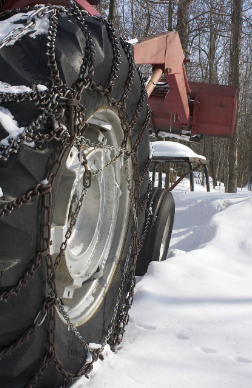Contents
How do you measure a tractor tire for chains? Here are two main methods to measure a tractor tire for chains:
Measure the Tire Yourself:
You’ll need some measuring tape and potentially some twine or string. Here’s what to do:
Optional: Deflate the tire: This can make it easier to get accurate measurements, but it’s not essential. Measure the Tread Width: Lay the tape measure flat across the widest part of the tire tread.
This will give you the overall width of the flat surface where the chains will make contact.
Measure the Inside Span: Here you have two options: String Method: Take a piece of twine or string and loop it around the inside of the tire, following the curve where the chains will sit. Mark the string where it meets itself. Lay the string flat and measure the distance between the marks. This is the inside span.
Tape Measure Method: If the tire allows, try to reach the center point of the tire with the tape measure and measure the distance from there to the edge of the rim on both sides. Subtract the rim width from this measurement (half on each side) to get the inside span.
Use the Tire Size Information:
Most tractor tires have a size printed on the sidewall. This code will include information about the width and diameter of the tire. While not ideal, you can sometimes find tractor tire chains sized based on this information. However, it’s important to note that:
It’s always best to double-check with actual measurements for the most accurate fit. Chains that are too loose can be ineffective and damage the tire, while excessively tight chains can put strain on the drivetrain.
Chain size might also depend on the specific link style and pattern of the chains you choose. Additional Tips:
Consult your tractor’s manual or the tire manufacturer’s website for specific recommendations on tire chain size. When purchasing tractor tire chains, always refer to the manufacturer’s sizing guide for their specific product.
If you’re unsure about the measurements or have any questions, consult with a tractor parts supplier or mechanic. They can help you ensure you get the right size chains for your tractor tires.
How to put chains on tractor trailer tires?
Tackling the task of putting on tractor trailer tire chains demands attention to detail and a focus on safety. Here’s a comprehensive guide to help you navigate through this physically demanding process with ease:
Preparation Phase:

Before diving into the task, ensure that your tractor-trailer is parked on a level and stable surface. Engage the parking brake firmly and use wheel chocks to secure the wheels that won’t be chained.
Gather all the necessary tools for the job: the tractor trailer tire chains, a pair of sturdy gloves (preferably with good grip), and a tensioning tool (often a turnbuckle) that typically comes with the chains.
Take a moment to consult the owner’s manual specific to your tire chains.
While the basic process remains the same, there might be slight variations in how they connect or tighten.
Putting on the Chains:
- Prepare the Chains: Lay out one set of chains over each tire that requires chaining up. Ensure that the hooks or connectors are facing outward and that the tensioning mechanisms are easily accessible.
- Position the Chains: Gently back up the tractor so that at least half of each chain is draped under the tire tread.
- Connect the Inside Sections: This step may require you to crawl under the vehicle. Securely attach the inside sections of the chains using hooks or threaded fasteners. Double-check to ensure proper seating and secure connections.
- Drive Forward Slightly: Move the tractor forward just enough to bring the remaining portion of the chain onto the tire tread.
- Connect the Outside Sections: Securely fasten the outside sections of the chains, ensuring that all connections are tight and secure.
- Tighten the Chains: Utilize the turnbuckle or tensioning tool to adjust the tension on the chains. Aim for approximately one inch of play between the chains and the tire surface. Avoid over-tightening, as it may lead to damage to the chains or tires.
- Double-Check Everything: Perform a thorough inspection to confirm that all connections are secure, the chains are evenly tensioned, and there are no loose parts that could pose a hazard.
- Repeat the Process: Follow the same steps for the other set of tires that require chaining up.
Additional Tips:
- Consider working with a partner to assist you during the process. Having an extra set of hands can be invaluable, especially when handling heavy chains or navigating tight spaces.
- Take your time and avoid rushing through the process. Prioritize accuracy and safety above all else.
- Dress appropriately for the task, wearing sturdy footwear with good traction, and dress according to the prevailing weather conditions.
- Maintain awareness of your surroundings throughout the process, ensuring that there’s ample space to maneuver safely and remaining vigilant for any potential hazards, such as passing traffic or uneven terrain.
By following these steps and tips, you can effectively and safely install tractor trailer tire chains, ensuring optimal traction and safety in challenging road conditions.
